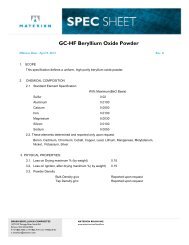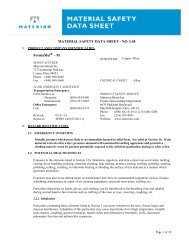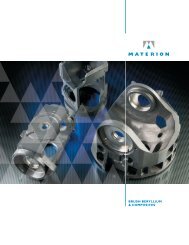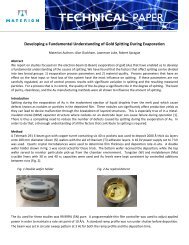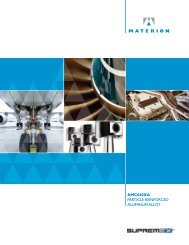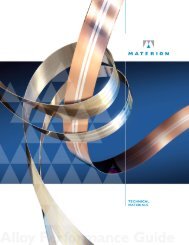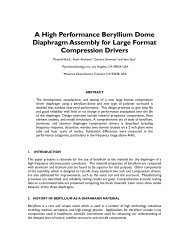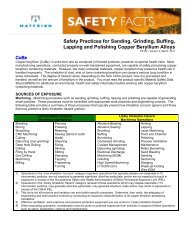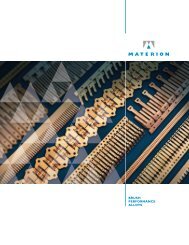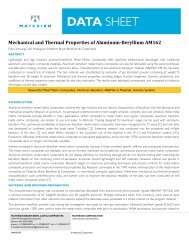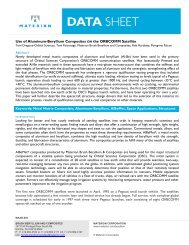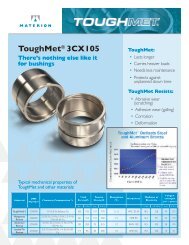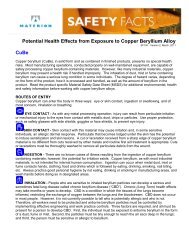Coating Materials News Vol 14 Issue 4 - Materion
Coating Materials News Vol 14 Issue 4 - Materion
Coating Materials News Vol 14 Issue 4 - Materion
Create successful ePaper yourself
Turn your PDF publications into a flip-book with our unique Google optimized e-Paper software.
This issue of CMN is focused<br />
on materials properties. It begins<br />
by outlining the primary<br />
properties that are desirable in<br />
a typical optical coating material.<br />
A preliminary report on<br />
CERAC’s latest material improvement<br />
– pre-melted<br />
titanium dioxide — is presented.<br />
These topics are followed by<br />
discussions on achieving mechanical<br />
and optical stability in<br />
selected coating materials, and<br />
on the theory of thin film<br />
growth.<br />
CERAC Pre-Melted TiO 2<br />
Lives up to Expectations<br />
In CMN <strong>Vol</strong>ume <strong>14</strong> / <strong>Issue</strong> 2 (June 2004),<br />
we described the introduction of pre-melted<br />
forms of popular oxide compounds. An<br />
evaluation program is underway that is comparing<br />
evaporation-ready pre-melted<br />
CERAC oxide compounds with material<br />
compounds supplied by other manufacturers.<br />
Preliminary results are reported here<br />
for the TiO 2 materials; a more complete report<br />
will appear in a future issue of CMN.<br />
CERAC’s objective in producing pre-melted<br />
oxide compounds is to provide ready-state<br />
materials, i.e., pre-conditioned forms, that<br />
eliminate the typical lengthy preparation<br />
time for deposition. One form that is especially<br />
beneficial is the cone-shape intended<br />
for common crucible or E-gun pocket. Production<br />
of TiO 2 film layers has always<br />
required the cyclic process of melting down<br />
the pieces of the starting compound, cooling,<br />
breaking vacuum, adding material on<br />
top of the melted slug, and repeating the<br />
steps until the crucible is filled with melted<br />
and outgassed material ready for deposition.<br />
For most oxide-compound materials<br />
supplied in piece or pressed tablet forms,<br />
this process requires at least 3 hours of<br />
continued on page 2<br />
What Properties Are Required in an<br />
Evaporation Material?<br />
Celebrating 40 Years of Manufacturing Excellence<br />
<strong>Vol</strong>ume <strong>14</strong> / <strong>Issue</strong> 4<br />
December, 2004<br />
For a material to be suitable for evaporation and use in depositing thin films for optical<br />
applications, whether by resistance-heating or electron beam-heating, it must possess<br />
specific properties. As an illustration we have constructed a relative comparison listing<br />
of the properties of three fluoride-based low-index materials that are popular for IR<br />
coatings: ThF 4 , IRX and YF 3 . These materials exhibit high transparency that extends<br />
from UV to IR wavelengths, and are used in multilayer AR and high reflectors requiring<br />
high damage thresholds to laser irradiation, and in edge filters, bandpass filters, and<br />
polarizers. Articles discussing IRX in greater depth can be found is past issues: CMN<br />
V3, <strong>Issue</strong> 3 (1994) and V4(5), <strong>Issue</strong> 1 (1994).<br />
The properties considered include the vaporization and condensation behaviors of the<br />
starting material, and the optical, chemical and mechanical durability of the deposited<br />
film. Some coating applications require survivability with retention of their physical<br />
properties when exposed to severe mechanical stresses such as high-speed rain drop<br />
impact, sand erosion, and salt fog tolerance. Other coatings must perform after continual<br />
exposure to weather and experience variable humidity and temperature conditions and<br />
perhaps mild abrasion in everyday use. <strong>Coating</strong>s for IR laser applications, particularly<br />
the CO 10.6 µm line, require high laser damage thresholds to irradiation. The fluorides<br />
2<br />
chosen to illustrate material properties (Table 1) are used in laser applications and in<br />
wide-band AR coatings operating to 11+ µm.<br />
Table 1. Comparison of Properties of Three IR Fluoride <strong>Materials</strong><br />
3
2<br />
Achieving Low Mechanical Stress in Thin Film Layers<br />
Thin film layers that have high tensile or<br />
compressive stress in relation to their substrates<br />
are vulnerable to mechanical failure<br />
that may take many forms, ranging from<br />
increased scatter due to micro-cracking to<br />
catastrophic flaking and peeling. In general,<br />
fluoride films grow with tensile stress<br />
while the stress in oxide-compound films<br />
can range from compressive to tensile, depending<br />
on many parameters. CMN<br />
previous issues have treated the subject of<br />
stress in thin-film layers: CMN V1, <strong>Issue</strong><br />
3 (1991); V2, <strong>Issue</strong> 3 (1992); and V11, <strong>Issue</strong><br />
4 (2001). Low-stress mixtures of oxide<br />
compounds were discussed in CMN V2,<br />
I3 (1992) and V8, I4 (1998). New information<br />
was presented at the Tucson 2004<br />
Optical Interference <strong>Coating</strong>s Meeting that<br />
deserves review.<br />
Zirconium dioxide is a material with exceptional<br />
hardness, moderately high refractive<br />
index and high transparency from ~300 nm<br />
to ~11 ì m, thus is useful in optical and<br />
tribological coatings. Layers of pure of<br />
ZrO 2 share a common characteristic with<br />
many refractory compounds: they exhibit<br />
inhomogeneous refractive index depth profiles,<br />
resulting in difficulties in applications<br />
such as efficient AR coatings. The origin of<br />
CERAC Pre-Melted TiO 2 , from page 1<br />
TiO 2 rod,<br />
cones &<br />
pieces<br />
this stress is known to be the presence of<br />
multiple or unstable crystalline forms<br />
throughout the layer.<br />
The effects of the thermal history on residual<br />
stress in ZrO 2 layers on glass were<br />
studied by monitoring the evolution of crystallinity<br />
using XRD [1]. Stress was<br />
measured in films that were deposited by<br />
E-beam on substrates at temperatures between<br />
room and 350° C. The room<br />
temperature films were then annealed in air<br />
for 1 hour at temperatures 200° C, 300° C<br />
and 400° C. For films deposited at room<br />
temperature to 190° C, the residual stress<br />
was tensile: 64 and <strong>14</strong> MPa, respectively.<br />
At 260° C the stress became -46 MPa compressive;<br />
and at 350° C it increased to -150<br />
MPa. Films deposited at room temperature<br />
changed from tensile to increasing values<br />
of compressive as the annealing temperature<br />
was increased, reaching -240 MPa at<br />
350° C. XRD showed evolving crystallinity<br />
from amorphous for films with thermal<br />
histories below 200° C to monoclinic and<br />
tetragonal at the higher temperatures. The<br />
densities and residual compressive stresses<br />
of the high- temperature films increase in<br />
correspondence with contraction of the<br />
microstructure with crystallization.<br />
chamber time. This non-productive<br />
use of vacuum chamber time<br />
has been reduced to
And Now for Some Theory on Film Growth<br />
It is clear that the optical and mechanical<br />
properties of materials condensed to thin<br />
solid film layers are different from those of<br />
the bulk parent materials. Efforts to understand<br />
the growth mechanisms that<br />
produce the deposited films and their peculiar<br />
characteristics have been underway<br />
since the first thin films were grown. The<br />
subject is a complex one because many factors<br />
are involved; two key ones are: surface<br />
substrate energy and arriving adatom energy.<br />
Certainly the chemical or reactive<br />
nature of the vapor species and the presence<br />
of additional gaseous species are<br />
important, and other variables need to be<br />
considered in the whole picture. Ultimately<br />
the goal is to develop growth structure<br />
models that permit prediction of the properties<br />
of deposited film layers. [7]<br />
The ideal thin film layer would be either a<br />
single crystal or possess an amorphous<br />
structure. The growth process from a physical<br />
vapor inevitably produces disordered<br />
films that contain high defect and impurity<br />
densities. Therefore, real films have a disordered<br />
polycrystalline microstructure<br />
with contaminants and other defects concentrated<br />
at the boundaries between the<br />
crystallites. In the cases of compound deposition,<br />
stoichiometry can be incorrect,<br />
leading to absorption or changes in electrical<br />
properties (in transparent conducting<br />
layers). Further, the film structure is in a<br />
metastable state, and in the presence of sufficient<br />
thermal or chemical energy can<br />
restructure to obtain permanently altered<br />
optical and mechanical properties. This<br />
can occur with coatings that are exposed to<br />
high energy laser radiation, high operating<br />
temperatures, and even conditions of high<br />
humidity.<br />
Thin-film growth models are based on an<br />
evolutionary progression that starts with<br />
nucleation on the substrate, assumes threedimensional<br />
growth of isolated islands that<br />
eventually coalesce, and finally grown in<br />
thickness to form a continuous layer. The<br />
conditions for nucleation and subsequent<br />
growth are dependent on the kinetic energy<br />
of the arriving adatoms and on the substrate<br />
surface energy. The latter is highly influenced<br />
by the atomic-level condition of the<br />
surface: the presence of contamination layers<br />
reduces the energy available for the<br />
generation of bonds, whether chemical or<br />
physical. It is not generally appreciated<br />
that the deposition atmosphere contains a<br />
high density of what should be considered<br />
“impurities”. These consist of residual water<br />
molecules, hydrocarbons, other organic<br />
and inorganic molecules degassing from the<br />
walls, and from the evaporation source, etc.<br />
These impurity species impinge on the substrate<br />
at rates comparable to that of the<br />
arriving adatoms, thus they are included<br />
within the growing film layer and are responsible<br />
for the internal defects and<br />
disorder and instability of the layer. Those<br />
impurities that are insoluble in the host<br />
material migrate to the grain boundaries<br />
where they are loosely bound in a metastable<br />
structure. Soluble impurities form<br />
part of the film matrix and can actually stabilize<br />
the film. Examples of the former are<br />
water in fluoride- or oxide-compound films<br />
and argon in sputtered films. Examples of<br />
the latter are mixtures of coating materials<br />
that are deliberately “doped” with soluble<br />
additives, and include IRX, and hafnia<br />
and zirconia and other oxides mixed with<br />
10-20% yttria, as discussed above.<br />
Nucleation and continuous growth can be<br />
encouraged by conditioning the substrate<br />
surface. We review some of the methods<br />
previously presented in past CMN issues.<br />
High substrate temperatures promote mobility<br />
through increased surface energy.<br />
However, high temperatures can create high<br />
intrinsic and thermal mismatch stresses and<br />
perhaps even deform or damage the substrate.<br />
Therefore, low temperature<br />
processes are being developed, especially<br />
for coating polymers. Removal of adsorbed<br />
water and organics can be accomplished<br />
with low energy discharges such as the traditional<br />
glow-discharge. Removal of bound<br />
species such as oxides can be done using<br />
higher-energy heavy Ar ions from an ion<br />
gun or pre-sputter step. Surface energy<br />
can be further changed by depositing suboxides<br />
of reactive metals and compounds.<br />
Typical examples are Cr, NiCr, Pd (for gold<br />
adhesion), Ti, etc. Compounds include suboxides<br />
of Ti, Ta, Cr, Y, etc. In reality, the<br />
precursor metal layers (of thickness
2<br />
P.O.Box 1178<br />
Milwaukee, WI 53201-1178<br />
USA<br />
Theory on Film Growth from page 3<br />
compositions with absorption that for general<br />
optical applications might not be<br />
acceptable, and is intolerably high for highenergy<br />
laser applications. E-beam coatings,<br />
on the other hand exhibit high laser damage<br />
resistance, but they are somewhat porous<br />
and thus can be unstable in varying humidity<br />
environments. Sputtered films are<br />
dense, but their stress levels need to be<br />
controlled, and the argon content might be<br />
problematical in some applications. The<br />
latest modifications in deposition employ<br />
higher adatom energy processes in attempts<br />
to simultaneously improve all film optical<br />
and mechanical qualities; they include reactive<br />
ion plating and high energy plasmas.<br />
To date, no process has solved all the problems,<br />
and coating engineers are forced to<br />
make compromises in adopting techniques<br />
that appear to be suitable for their current<br />
specific coating needs. The availability of<br />
coating materials with improved consistency<br />
removes one of the variables that<br />
plague optical thin-film deposition and<br />
growth.<br />
Achieving Spectrally Stable<br />
Layers from page 2<br />
creased ~-1.6%. The researchers concluded<br />
that the porosity decrease of the film matrix<br />
is responsible for the index decrease.<br />
Any aging effects that the HfO 2 layers might<br />
be responsible for were not considered, but<br />
probably should be explored in future investigations.<br />
Other researchers reported<br />
that silica hydrolysis induces a shift in mechanical<br />
stress from compressive to tensile<br />
[5, 6].<br />
The deposition process for widely used<br />
SiO 2 low-index films and other oxides<br />
should be capable of producing layers with<br />
as high a packing density as possible in order<br />
to discourage unstable optical and<br />
mechanical properties. The porosity and<br />
thus the magnitude of the moisture-induced<br />
shift can be reduced by deposition at high<br />
substrate temperature, but not eliminated.<br />
Densification to the degree that the spectral<br />
shift is reduced to



